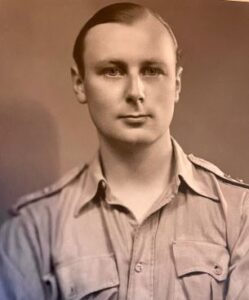Pat Lancaster was born in 1914, the year of the outbreak of the First World War. After leaving Charterhouse he obtained a degree in Agriculture at Oxford as he intended to become a farmer. However, as by then it was apparent to him that war with Germany was inevitable, he decided instead to become a professional soldier.

Pat was commissioned into 3rd The King’s Own Hussars at Tidworth in 1934, when the regiment was still mounted and one of his duties as a subaltern was schooling the remounts. Two years later the regiment was fully mechanised and war broke out in 1939.
In August 1940 the regiment sailed for Port Said and Pat served in the desert ultimately commanding a composite squadron in an attempt to relieve Tobruk. For this action, the regiment was awarded a battle honour.
Selected to join ‘B’ Squadron which was to be sent to relieve Singapore, Pat set sail with the rest of the squadron in January 1942. However, Singapore fell before they reached it and the squadron was diverted first to Sumatra and then to Java. When the island was overrun by the Japanese, any attempt to evade capture was pointless as the Dutch had destroyed most of the ships before surrendering so there was no means of escape from the island. Along with the remaining survivors of the squadron, Pat spent the next three and a half years as a prisoner of war during which nearly half the squadron who were captured died. Like most of those who endured the brutalities of that experience, he never discussed it.
As well as being a lover of literature, Pat also inherited a love of education from his grandfather, a Norfolk farmer’s son, who had risen to become a main board director of ‘The Prudential’. He paid for the rebuilding of Lynn Grammer School to satisfy his feeling a need to repay his debt to society for his good fortune. This love led Pat to use some of his time in captivity to improve the education of the soldiers.
Pat was repatriated upon being freed but was sad to find his wife, Masika (‘Sika’) was not at home to greet him when he returned. As a model maker and PA to the chief engineer of Mulberry Harbour, Sika was in America for a conference/presentation of the planning and execution of this successful operation which established a bridgehead for the reclamation of Europe.
Pat rejoined the 3rd Hussars then stationed at Catterick for a short time, but he left to realise his original ambition to become a farmer. First, he rented a farm just outside Abingdon and later he bought Wapsbourne Manor, Sheffield Park, East Sussex only a short distance from Maresfield where the Regiment was based from 1967 to 1970. Members of the Regiment were generously entertained by Pat and Sika at Wapsbourne during which Pat would entertain the guests with anecdotes about his time in the regiment all of which were recounted with his usual sharp wit. Pat and Sika were frequent guests of the regiment at Maresfield.
Pat Lancaster died on 20th May 1986.
Pat and Sika Lancaster’s son, Hugh, served in The Queen’s Own Hussars from 1967 to 1971.


